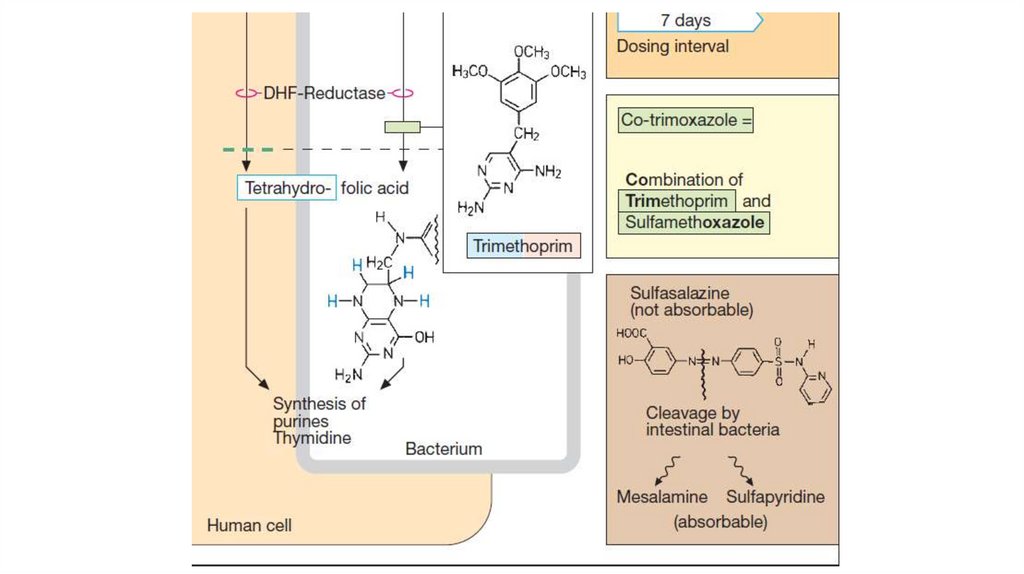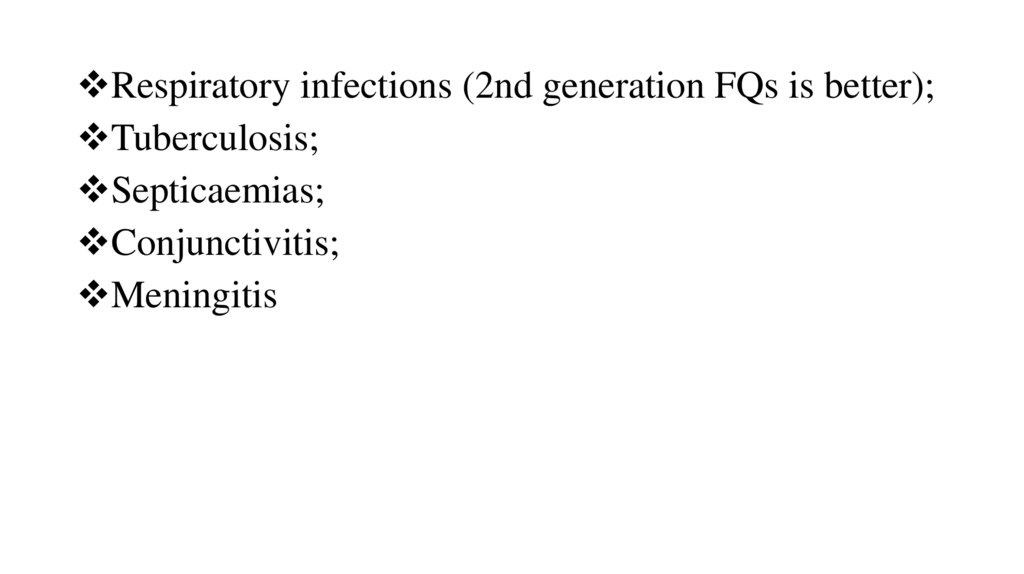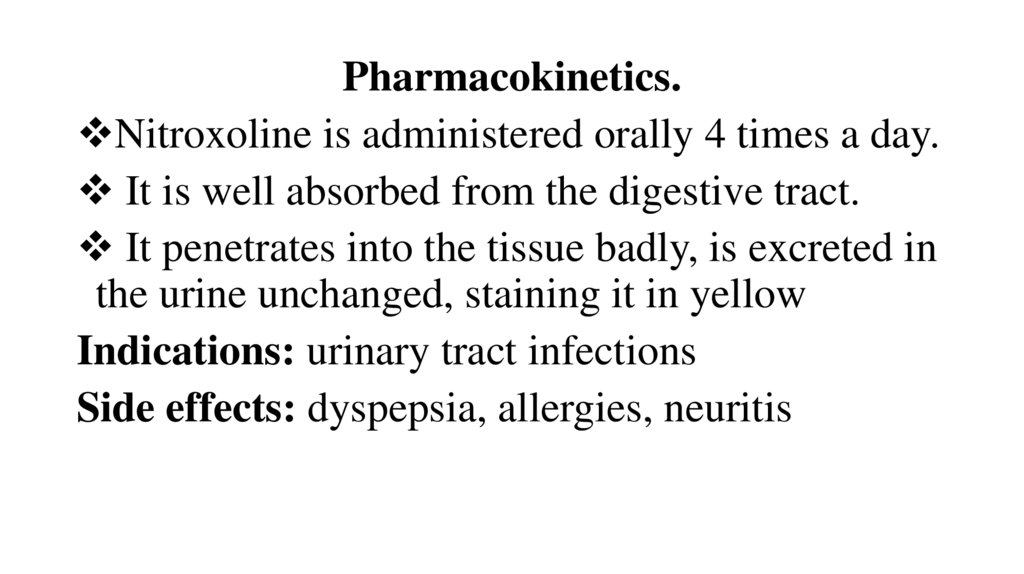Similar presentations:
Antimicrobial drugs
1. Antimicrobial drugs
Disinfectants and AntisepticsAntibacterial chemotherapeutic
drugs
2.
Antimicrobial drugs have antimicrobial properties. They aredivided into 2 groups:
Disinfectants and Antiseptics (drugs are used locally)
Antibacterial chemotherapeutic drugs are applied
resorptively.
Type of action:
A. Bacteriostatic: drugs delay the growth and reproduction
of bacterial cells.
B. Bactericidal: drugs cause cell death.
3.
4.
Disinfectants and Antiseptics• Disinfection denotes the inactivation or killing of
pathogens (protozoa, bacteria, fungi, viruses) in the
human environment (instruments, equipment,
premises, dishes, patients’ excrements). They provide
a rapidly developing effect. They are applied at
bactericidal concentration and aimed at the prevention
of the spread of infection.
5.
Phenol was the first antiseptics.Phenol coefficient (the ratio between the
concentration of phenol and the antiseptic
under test, in which both substances provide
equal antimicrobial effect) is a common
measure of antiseptic activity.
6.
Antisepsis refers to the reduction by chemical agentsof germ numbers on skin and mucosal surfaces.
Agents for chemical disinfection ideally should cause
rapid, complete, and persistent inactivation of all
germs, but at the same time exhibit low toxicity
(systemic toxicity, tissue irritancy, antigenicity) and
be non-deleterious to inanimate materials. But
anticeptics are highly toxic and can cause side
effects: local irritant and cauterizing effect.
At higher concentrations they are disinfectants.
7.
• Disinfectants come from various chemical classes,including oxidants, halogens or halogen-releasing agents,
alcohols, aldehydes, organic acids, phenols, cationic
surfactants (detergents) and formerly also heavy metals.
The basic mechanisms of action involve denaturation of
proteins, inhibition of enzymes, or a dehydration. Effects
are dependent on concentration and contact time.
• Activity spectrum. Disinfectants inactivate bacteria
(gram-positive > gram-negative > mycobacteria), less
effectively their sporal forms, and a few (e.g.,
formaldehyde) are virucidal.
8.
ApplicationsSkin “disinfection.” (Reduction of germs before
injections or surgical procedures). Useful agents
include: alcohols (ethanol) 70–90%; iodine-releasing
agents like povidone, cationic surfactants, and
mixtures of these. Minimal contact times should be at
least 15 s on skin .
Mucosal disinfection: Germ counts can be reduced by
PVP iodine or chlorhexidine (contact time 2 min),
although not as effectively as on skin.
9.
10.
Wound disinfection can be achieved with hydrogenperoxide or with potassium permanganate, as well as
PVP iodine, chlorhexidine, and biguanidines.
Hygienic and surgical hand disinfection: is
required after a suspected contamination, before
surgical procedures. Alcohols, mixtures of alcohols
and phenols, cationic surfactants, or acids are
available for this purpose.
Admixture of other agents prolongs duration of
action and reduces inflammation
11.
12.
• Disinfection of instruments: Instruments thatcannot be heat- or steam sterilized can be
precleaned and then disinfected with aldehydes
and detergents.
• Surface (floor) disinfection employs aldehydes
combined with cationic surfactants and oxidants
or, more rarely, acidic or alkalizing agents.
13.
Chemotherapeutic drugs inhibit/kill the infecting organismand have no/minimal effect on the recipient. They can be
divided:
• Antibiotics are produced by microorganisms.
• Synthetic drugs.
These drugs influence specific microorganism and have
wide therapeutic window. They suppress the growth of or
kill other microorganisms at very low concentrations. They
are used for the treatment and prevention of diseases, for the
treatment of infection carries.
14.
Basic principles of chemotherapyEarly start of treatment.
Determination of the causative agent, its sensitivity to the
drug.
The use of optimum doses.
Accounting pharmacokinetics of the drug: the degree of
absorption, distribution, features of excretion, duration of
action.
Accounting for toxicity of drugs.
Carrying out a full course of treatment (5-10 days).
If necessary – the possibility of combining drugs.
15. SULFONAMIDES
Sulfonamides were the first antimicrobialagents (AMAs) effective against pyogenic
bacterial infections.
All sulfonamides are derivatives of
sulfanilamide.
Individual members differ in the nature of N1
substitution, which governs solubility, potency
and pharmacokinetic property.
A free amino group in the para-position (N4) is
required for antibacterial activity.
16.
17.
• Sulfonamides are primarily bacteriostatic against manygram-positive and gram-negative bacteria. However,
bactericidal concentrations may be attained in urine.
Sensitivity patterns among microorganisms have
changed from time-to-time and place-to-place.
• Those still sensitive are: Streptoс. pyogenes,
Haemophilus Influenzae, Vibrio cholerae, Staph.
aureus, gonococci, meningococci, pneumococci,
Escherichia coli, Shigella, Chlamydiae, Actinomyces,
Nocardia and Toxoplasma.
• Anaerobic bacteria are not susceptible now.
18.
1. Preparations used for their systemic action:Short acting (4–8 hr): Sulfadiazine, sulfadimidine
Intermediate acting (8–12 hr): Sulfamethoxazole
Long acting (12-24 days): Sulfamethoxypyrazine,
sulfadimethoxine
With a very long-term action (more 7 days): Sulfadoxine,
sulfalene
2. D. acting in the intestinal lumen: phthalylsulphathiazole
3. D. for topical use: sulfacetamide sodium, silver sulfadiazine
19.
• The mechanism is connected with their competitiveantagonism with para-aminobenzoic acid (PABA).
Sulfonamides block dihydropteroate synthetase also. They
inhibit the union of PABA with pteridine residue to form
dihydropteroic acid which conjugates with glutamic acid to
produce dihydrofolic acid. They inhibit bacterial folate
synthase → FA is not formed and a number of essential
metabolic reactions suffer.
• Human cells also require FA, but they utilize preformed FA
supplied in diet and are unaffected by sulfonamides.
20.
• Sulfonamides are rapidly and nearly completely absorbedfrom G.I.T. Extent of plasma protein binding differs
considerably (10–95%) among different members. The
highly protein bound members are longer acting.
Sulfonamides are widely distributed in the body—enter
serous cavities easily. The free form of sulfadiazine attains
the same concentration in CSF as in plasma. They cross
placenta freely.
• The primary pathway of metabolism of sulfonamides is
acetylation primarily in liver.
• The acetylated derivative is inactive, but can contribute to the
adverse effects. It is generally less soluble in acidic urine
than the parent drug—may precipitate and cause crystalluria.
21.
• Sulfonamides are excreted mainly by the kidney throughglomerular filtration. Both renal tubular secretion and
reabsorption occur. The more lipid-soluble members are
highly reabsorbed in the tubule, therefore are longer
acting.
• Phthalylsulphathiazole is not absorbed from GIT and acts
there. So it can be used for the treatment of intestinal
infections.
22.
Side effects:Nausea, vomiting and epigastric pain.
• Crystalluria . Precipitation in urine can be minimized by taking
plenty of fluids and by alkalinizing the urine in which
sulfonamides and their acetylated derivatives are more soluble.
• Hypersensitivity reactions (rashes, urticaria and drug fever).
• Photosensitization.
• Hepatitis, unrelated to dose.
• Haemolysis can occur in G-6-PD deficient individuals with
high doses of sulfonamides.
23.
USES:• suppressive therapy of chronic urinary tract infection;
• ear, throat, nose infections;
• gum infection;
• malaria and toxoplasmosis.
• Ocular sulfacetamide sod. (10–30%) is a cheap
alternative in trachoma and conjunctivitis,
• Topical silver sulfadiazine is used for preventing
infection on burn surfaces.
24.
The fixed dose combination of trimethoprim andsulfamethoxazole is called cotrimoxazole.
Trimethoprim selectively inhibits bacterial dihydrofolate
reductase (DHFRase).
25.
26.
Individually, both sulfonamide and trimethoprim arebacteriostatic, but the combination becomes bacteriocidal
against many organisms.
• Spectrum of action of trimethoprim and sulfonamides
overlap considerably. Additional organisms covered by the
combination are—Salmonella typhi, Serratia, Klebsiella,
Enterobacter, Yersinia enterocolitica, Pneumocystis and
many sulfonamide-resistant strains of Staph. aureus, Strep.
pyogenes,
Shigella,
enteropathogenic
E.
coli,
H.influenzae, gonococci and meningococci.
27.
UsesUrinary tract infections (acute cystitis, prostatitis);
Respiratory tract infection caused by gram positive cocci
and H. influenzae;
Bacterial diarrhoeas and dysentery caused by E. coli,
Shigella, nontyphoid Salmonella, and Y. enterocolitica;
Pneumonia in neutropenic and AIDS patients caused by
Pneumocystis jiroveci;
Chancroid.
28.
Side effects of cotrimoxazole• Nausea, vomiting, stomatitis, headache and
• Folate deficiency (megaloblastic anaemia).
• Cotrimoxazole should not be given during pregnancy.
Trimethoprim is an antifolate, there is theoretical
teratogenic risk.
• Neonatal haemolysis and methaemoglobinaemia can
occur if it is given near term.
29. QUINOLONES
1.Quinolones (without F)Nalidixic acid
2.First generation
fluoroquinolones
• Norfloxacin, Ofloxacin,
Ciprofloxacin, Pefloxacin
3. Second generation
fluoroquinolones
• Levofloxacin, Lomefloxacin,
Prulifloxacin, Moxifloxacin
30.
31.
Nalidixic acid• It is active against gram-negative bacteria ( E. coli, Proteus,
Klebsiella, Enterobacter, Shigella but not Pseudomonas).
• It acts by inhibiting bacterial DNA gyrase and is
bactericidal. Resistance to nalidixic acid develops rather
rapidly.
• Nalidixic acid is absorbed orally, highly plasma protein
bound and partly metabolized in liver: one of the
metabolites is active. It is excreted in urine . T½ ~8 hrs.
32.
• Nalidixic acid is primarily used as a urinaryantiseptic. It has also been employed in diarrhoea
caused by Proteus, E. coli, Shigella or
Salmonella.
• Adverse effects: g.i. upset and rashes; headache,
drowsiness, vertigo, visual disturbances,
occasionally seizures (especially in children);
phototoxicity; haemolysis.
33.
FLUOROQUINOLONESThese preparations exhibit a bactericidal effect.
Mechanism of action is associated with the
inhibition of bacterial enzymes – topoisomerases
II (DNA- gyrase) and IV. This impairs DNA
replication and RNA formation. All this
interferes with bacterial growth and division.
34.
The spectrum of action of First generation fluoroquinolones• Highly susceptible: Neisseria gonorrhoeae; N. meningitidis; E.
coli; K. pneumoniae; Enterobacter; H. influenzae; Salmonellas;
Campylobacter; Shigella; Yersinia enterocolitica; Proteus; Vibrio
cholerae
• Moderately susceptible: Pseudomonas aeruginosa; Legionella;
Staph. Aureus (including few MRSA); Brucella; Listeria;
Bacillus anthracis; Mycobact. tuberculosis
• Organisms which have shown low/variable susceptibility are:
Streptococci, Mycoplasma, Chlamydia.
• Notable resistant bacteria are: Bacteroides fragilis, Clostridia,
anaerobic cocci.
35.
The spectrum of action of 2 generationfluoroquinolones
They are more active against gram-positive
bacteria. They suppress Streptococci,
Staphylococci, listeria, Corinebacteria, Enterococci,
Pneumococci, Chlamydia, Mycoplasma,
Ureaplasma, anaerobic microorganism.
Their bactericidal activity against gram-negative
bacteria is also maintained.
36.
Pharmacokinetics:Drugs are absorbed from the gastrointestinal tract at
60-100%,
They bind to proteins of blood.
They penetrate the tissues and body fluids, in the cells
very well.
They can pass through the BBB.
They are excreted in the active form by the kidneys.
They are prescribed 1-2 times a day.
There are drugs for intravenous and topical use.
37.
UsesUrinary tract infections;
Gonorrhoea;
Chancroid;
Bacterial gastroenteritis: dysentery, salmonellosis,
cholera;
Typhoid;
Bone (osteomyelitis, joint infections), soft tissue,
gynecological and wound infections;
38.
Respiratory infections (2nd generation FQs is better);Tuberculosis;
Septicaemias;
Conjunctivitis;
Meningitis
39.
40.
Side effectsDyspeptic disorders (nausea, vomiting, anorexia, diarrhea);
Allergic reactions (rash, itching), photosensitization;
Dizziness, headache, insomnia, mood changes,
convulsions;
Anemia, thrombocytopenia;
Tendovaginitis, myalgia, arthralgia;
Dysbacteriosis;
Impaired liver and kidney function.
Contraindications: to pregnant women and children under 2
years of age due to the risk of damage to cartilaginous
tissue.
41.
Derivative of 8-hydroxyquinoline – NitroxolineMechanism: reducing the activity of enzymes due to
the formation of complexes with metals.
Type: bacteriostatic or bactericidal depending on the
dose;
Spectrum: enterobacteria (Escherichia, Shigella,
Klebsiella, some Proteus strains), protozoa (amoeba,
Giardia), the fungus Candida.
42.
Pharmacokinetics.Nitroxoline is administered orally 4 times a day.
It is well absorbed from the digestive tract.
It penetrates into the tissue badly, is excreted in
the urine unchanged, staining it in yellow
Indications: urinary tract infections
Side effects: dyspepsia, allergies, neuritis
43.
Nitrofuran derivativesNitrofural : antiseptic
Furazolidon: intestinal infections, giardiasis, Trichomonas
colpitis
Nifuroxazide: intestinal infections.
Nitrofurantoin (Furadonin), Furazidin (Furagin):
uroinfection.
Spectrum:
Gram-negative bacteria: Escherichia coli, Shigella,
Salmonella, Klebsiella
Cocci (entero-, staphylo-,strepto-, meningo-, gonorrhea)
Vibrio cholerae, Giardia, Trichomonas
44.
Mechanism:The restoration of the nitro group to the amino group
under the influence of reductase microbial cells.
The formation of complexes with nucleic acids,
Disruption of the respiratory mechanisms of
microorganisms.
Increase in the body's resistance to infections.
The decline in the production of toxins.
Type of action: bacteriostatic or bactericidal
45.
PharmacokineticsThey are absorbed from the digestive tract at 30
(furazolidon) – 50 %.
They penetrate the lymph, bile. They accumulate in
the bile.
They go through the placenta, they go through the
BBB badly.
They are excreted by the kidneys in different forms.
They are used 3-4 times a day.
46.
Side effectsDyspeptic disorders: nausea, vomiting, diarrhea;
Cholestasis; disorders of liver function;
Allergic reaction;
Headache, dizziness;
Hemolytic anemia, methemoglobinemia in children up to a
year;
Arterial hypertension;
47.
NitroimidazolesMetronidazole, Tinidazole, Ornidazole
Spectrum:
• Entamoeba histolytica, Trichomonas vaginalis, lamblia,
• Bact. fragilis, Fusobacterium, Clostridium perfringens, Cl.
difficile,
• Helicobacter pylori,
• Campylobacter, peptococci,
• spirochetes and anaerobic Streptococci
• enterobacteria in the presence of Bac.fragilis.
48.
49.
Mechanism of actionMetronidazole is selectively toxic to anaerobic and
microaerophilic microorganisms. After entering the cell by
diffusion, its nitro group is reduced by certain redox
proteins to a highly reactive nitro radical which exerts
cytotoxicity. The nitro radical of metronidazole acts as an
electron sink which competes with the biological electron
acceptors of the anaerobic organism for the electrons
generated by the pyruvate (pyruvate oxidation). The energy
metabolism of anaerobes that have no mitochondria is
disrupted. Aerobic environment attenuates cytotoxicity of
metronidazole by inhibiting its reductive activation.
50.
• They are almost completely absorbed from the smallintestines; little unabsorbed drug reaches the colon. They
are widely distributed in the body, attaining therapeutic
concentration in vaginal secretion, semen, saliva and CSF.
Metabolism occurs in liver primarily by oxidation and
glucuronide conjugation followed by renal excretion.
• Plasma t½ of Metronidazole is 8 hrs;
• Plasma t½ of Tinidazole 12 hr;
• Plasma t½ of Ornidazole 12–14 hr.
51.
Indications for usesAmoebiasis
Giardiasis
Trichomonas vaginitis
Anaerobic bacterial infections (after colorectal or pelvic
surgery, appendicectomy, brain abscesses and endocarditis)
Pseudomembranous enterocolitis (Cl. Difficile)
Acute necrotizing ulcerative gingivitis (fusobacteria,
spirochetes and bacteroides)
Helicobacter pylori gastritis/peptic ulcer
Guinea worm infestation
52.
Side effects• Anorexia, nausea, metallic taste and abdominal cramps are the
most common.
• Less frequent side effects are—headache, glossitis, dryness of
mouth and dizziness.
• Allergic reactions (urticaria, flushing, heat, itching, rashes)
• Prolonged administration may cause peripheral neuropathy and
CNS effects. Seizures have followed very high doses.
• Leucopenia is likely with repeated courses.
• Thrombophlebitis of the injected vein occurs if the solution is not
well diluted.
• They are contraindicated in neurological disease, first trimester of
pregnancy
53.
OXAZOLIDINONE - Linezolid• It is active against Staphylococcus aureus, penicillinresistant
Streptococci,
M.
tuberculosis,
Corynebacterium, Listeria, Clostridia and Bact.
fragilis.
• It is primarily bacteriostatic, but can exert cidal action
against some streptococci, pneumococci and B.
fragilis.
• Gram-negative bacteria are not affected.
54.
Linezolid inhibits bacterial protein synthesis by acting atan early step.
Linezolid is rapidly and completely absorbed orally,
partly metabolized nonenzymatically and excreted in urine.
Linezolid given orally or i.v. is used for uncomplicated
and complicated skin and soft tissue infections,
pneumonias, bacteraemias and other drug-resistant grampositive infections
Side effects: dyspepsia, diarrhea, constipation, insomnia,
dizziness, rash.
55.
Quinoxaline derivatives – quinoxidine and dioxidineSpectrum:
Proteus,
Pseudomonas
aeruginosa,
intestinal bacteria, cocci, Clostridium, bacteroids.
Application: orally, IV and locally in the case of the
inefficiency of other drugs in severe pleurisy, lung
abscesses, peritonitis, pyelonephritis.
Complications: dyspepsia, headache, dizziness,
allergic reactions, chills, intestinal candidiasis,
convulsions, carcinogenesis, teratogenicity.
56. Literature
1. Tripathi K.D. Essentials of Medical Pharmacology. Eighth Edition. -2019.- Jaypee Brothers MedicalPublishers. The Health Sciences Publisher. -New Delhi. London. Panama
2. D.A.Kharkevich. Pharmacology. Textbook for medical students. Translation of 12th edition of Russion
textbook “Pharmacology” (2017). – М., ГЭОТАР-Медиа, 2017.
3. Review of pharmacology. Gobind Rai Garg, Sparsh Gupta. 13th edition. - 2019.- Jaypee Brothers Medical
Publishers. The Health Sciences Publisher. -New Delhi. London. Panama
4. Whalen Karen. Lippincott Illustrated Reviews: Pharmacology. Sixth Edition. - Wolters Kluwer. - 2015.Philadelphia
5. Color Atlas of Pharmacology. 2nd edition, revised and expanded. Heinz Lüllmann.- 2000 Thieme
6. Pharmacology Examination & Board Review. Tenth Edition. Trevor Anthony J., Katzung Bertram G.,
Kruidering-Hall Marieke, Susan B. Masters. - a LANGE medical book. - 2013.-New York
7. Medical Pharmacology at a Glance. Eighth Edition. Neal Michael J. – 2016. John Wiley & Sons, Ltd.
8. USMLE Step 1. Lecture Notes. Pharmacology. Lionel P.Raymon and others.- Kaplan Medical.Inc. -2009
























































 medicine
medicine








